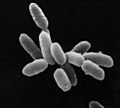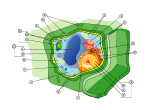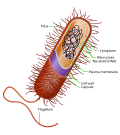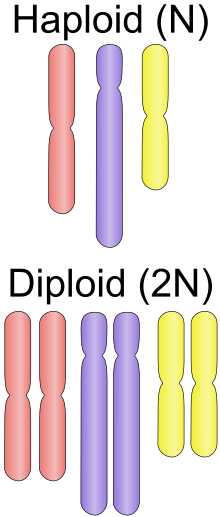Halobacterium (common abbreviation Hbt.) is a genus in the family Halobacteriaceae. The genus Halobacterium ("salt" or "ocean bacterium") consists of...
27 KB (2,462 words) - 12:43, 22 June 2024
Halobacterium salinarum, formerly known as Halobacterium cutirubrum or Halobacterium halobium, is an extremely halophilic marine obligate aerobic archaeon...
25 KB (2,487 words) - 18:09, 3 August 2024
Halobacterium noricense is a halophilic, rod-shaped microorganism that thrives in environments with salt levels near saturation. Despite the implication...
23 KB (2,610 words) - 08:04, 12 December 2023
archaea, which may vary from lake to lake. The most common archaeon is Halobacterium salinarum. Pink lakes arise from a combination of factors, which include...
13 KB (1,370 words) - 07:58, 9 July 2024
light-driven H+ ion transporter found in some haloarchaea, most notably Halobacterium salinarum (formerly known as syn. H. halobium). The proton-motive force...
21 KB (2,122 words) - 08:09, 8 March 2024
the water changes is a result of green alga Dunaliella salina, halobacterium Halobacterium cutirubrum, and/or high concentration of brine prawn. Once the...
9 KB (962 words) - 16:17, 23 July 2024
glycoprotein, and occurs in the hyperthermophiles, Halobacterium, and some methanogens. In Halobacterium, the proteins in the wall have a high content of...
43 KB (4,781 words) - 15:39, 10 June 2024
instead of water, producing sulfur instead of oxygen. Archaea such as Halobacterium also perform a type of non-carbon-fixing anoxygenic photosynthesis,...
109 KB (11,776 words) - 19:45, 6 August 2024
high as 130 °C (266 °F), as low as −17 °C (1 °F) Halophiles such as Halobacterium salinarum (an archaean) thrive in high salt conditions, up to saturation...
73 KB (7,743 words) - 22:00, 15 August 2024
inorganic energy sources. No known archaea carry out photosynthesis (Halobacterium is the only known phototroph archeon but it uses an alternative process...
156 KB (16,493 words) - 15:57, 9 August 2024
widespread and conserved nature of the organelle. Cleavage of a plasmid in Halobacterium halobium resulted in the loss of the ability to biosynthesize gas vesicles...
22 KB (2,713 words) - 07:53, 6 May 2024
cultures grown in synthetic minimal media are not polyploid. The archaeon Halobacterium salinarium is polyploid and, like Deinococcus radiodurans, is highly...
81 KB (8,829 words) - 02:44, 15 July 2024
Myohalovirus (redirect from Halobacterium phage phiH)
The following three species are assigned to the genus: Halobacterium virus ChaoS9 Halobacterium virus phiH Natrialba virus PhiCh1 Myohaloviruses are nonenveloped...
3 KB (285 words) - 12:48, 30 January 2023
such as Halobacterium and Haloquadratum that inhabit the same environments. Phenotypically, Salinibacter is remarkably similar to Halobacterium and therefore...
22 KB (1,887 words) - 20:55, 6 June 2024
protein found in different phyla of bacteria and archaea for example in Halobacterium salinarum or Haloferax mediterranei. Gas vesicles are small, hollow...
4 KB (425 words) - 01:39, 29 November 2023
(chemical energy) during photosynthesis in the halophilic archaeal organism Halobacterium salinarum (syn. H. halobium). The archaeal cell wall is omitted....
25 KB (3,154 words) - 13:29, 22 July 2024
Halogeometricum, Halococcus, Haloterrigena, Halorubrum, Haloarcula, and Halobacterium. However, the viable counts in these cultivation studies have been small...
22 KB (2,705 words) - 23:57, 27 May 2024
known to be naturally competent for transformation. Among archaea, Halobacterium volcanii forms cytoplasmic bridges between cells that appear to be used...
44 KB (4,770 words) - 11:49, 31 July 2024
DNA sequencing and detected Haloquadratum, Haloferax, Salinibacter, Halobacterium, Halogeometricum, and several other halophilic organisms. Culturing...
11 KB (1,195 words) - 21:25, 23 July 2024
their sole source of ATP, unlike several other halobateriacae, such as Halobacterium salinarum they are incapable of photophosphorylation as they lack the...
23 KB (2,506 words) - 23:36, 7 August 2024
ribonucleic acid. "Escherichia coli 16S ribosomal RNA". 13 June 2017. "Halobacterium salinarum 16S ribosomal RNA". 7 August 1991. "Homo sapiens 18S ribosomal...
3 KB (230 words) - 18:25, 26 August 2023
different morphologies. These diverse morphologies include rods in genus Halobacterium, cocci in Halococcus, flattened discs or cups in Haloferax, and other...
19 KB (1,179 words) - 16:17, 7 December 2023
archaeon was performed in 1971, when the RNAP from the extreme halophile Halobacterium cutirubrum was isolated and purified. Crystal structures of RNAPs from...
41 KB (4,799 words) - 19:34, 17 April 2024
Archaerhodopsin — A family of retinal-containing photoreceptor proteins found in Halobacterium and Halorubrum Boring Billion — a later phase during the Proterozoic...
10 KB (1,092 words) - 07:57, 29 July 2024
generating the phototaxis signal. Sensory rhodopsin II is found in Halobacterium salinarum and Natronomonas pharaonis. Structure of sensory rhodopsin...
3 KB (244 words) - 06:31, 1 January 2024
Lactococcus lactis. Even the phosphoproteome of an archaean organism, namely Halobacterium salinarium, is available. The integration of phosphoproteomes identified...
2 KB (163 words) - 01:27, 30 April 2022
planetary ejection Atmospheric reentry Simulated conditions Halobacterium noricense Halobacterium salinarum Halococcus dombrowskii Halorubrum chaoviatoris...
47 KB (3,687 words) - 07:32, 2 July 2024
the first genome sequence and genetic code for a halophilic microbe, Halobacterium sp. NRC-1. This work showed that its proteins are highly acidic, providing...
14 KB (1,429 words) - 15:59, 17 December 2023
characteristic of the bacterium Deinococcus radiodurans and of the archaeon Halobacterium salinarum. These two species are highly resistant to ionizing radiation...
53 KB (5,964 words) - 07:57, 29 July 2024
Oesterhelt, Dieter (December 2008). "Flagellar Rotation in the Archaeon Halobacterium salinarum Depends on ATP". Journal of Molecular Biology. 384 (1): 1–8...
65 KB (7,151 words) - 19:55, 31 July 2024





















